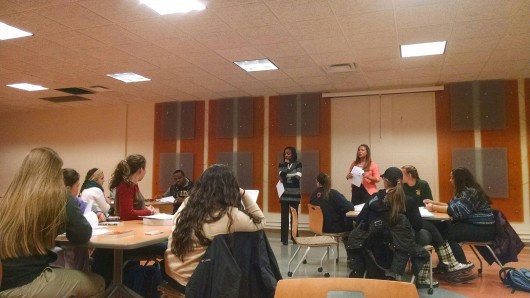
Students participate in a poverty simulation put on by service group Pay it Forward on Nov. 18.
Credit: Leisa DeCarlo / Lantern reporter
Combating poverty might not be a battle beyond the reach of college students. Ohio State students can help fight against the war on poverty in Columbus, said Patricia Cunningham, OSU director of social change.
“This is the 50th year of our war on poverty,” Cunningham said.
OSU’s campus is located directly in the middle of many of Columbus’s impoverished areas, said Miracle McGowan, a 2014 graduate in criminal justice studies.
Members of the OSU student organization Buckeye Civic Engagement Connection led a poverty simulation for OSU students Tuesday to expose them to what it might be like to live in poverty in Ohio’s capital. The simulation was hosted by student service group Pay It Forward as part of the month-long Battle Against Hunger initiative.
“The poverty simulation is an interactive three-hour program that allows participants to begin to think about poverty and discuss how communities can address (these) problems collectively,” Pay It Forward adviser Jake Cohen said in an email.
The simulation was funded through Pay It Forward’s general funds and the student activity fee, Cohen said.
According to the BCEC website, the organization works to connect Buckeyes with nearby communities, focusing on programming for individuals, families and communities facing poverty. Members are trained to work to develop poverty solutions that address health, education, design and economics in urban and rural communities.
The mission of the organization is to “provide a pathway out of poverty,” according to its website.
During the simulation, OSU students participated in multiple group activities. The first, “Groceries on a Budget,” prompted students to compose a plan to feed a family for a month with a strict $30 budget.
Poverty often spawns from a disadvantage of resources, such as in a community where children do not have access to the resources they need to succeed, Cunningham said. An example of these types of disadvantages is food insecurity, she said.
“Food insecurity has to do with individuals in our society who do not have reliable access to a sufficient quantity of affordable, nutritious food,” Cohen said.
Among maintaining a presence in various “neighborhood touchstones,” such as Columbus city libraries, recreation centers, food pantries and nursing homes, members of BCEC work with children who attend Columbus City Schools in impoverished areas, said BCEC member Brea Porter, a third-year in public health. The interaction with these children is facilitated by OSU students.
A significant contributor to the poor performance level of children raised in poverty is a lack of nutrition, Cunningham said.
“These kids are not deficits, but they live in deficits,” Cunningham said. “It’s more important for us to help them deal through life differently.”
It’s adults making poor decisions about children that led to these problems, Cunningham said.
During the simulation, participating Buckeyes chose to buy products such as bread, milk and frozen vegetables with their allotted budget.
About 60 percent of the foods students listed are not available in “food deserts,” Porter said. A “food desert” is an area where access to fresh fruits and vegetables is not within walking distance, she said.
“Some of them (children living in poverty) have never seen grapes or granola bars. It’s a whole type of exposure thing,” Porter said.
The two activities were meant to show that people who live below the poverty level have to confront obstacles that others might not think of on a daily basis, McGowan said.
BCEC also aims to bring experiential learning and familiarity to Columbus City Schools in areas of significant poverty.
“We’re like really familiar faces. We might be one of the most consistent faces that they see, encouraging them every day,” said BCEC member Joe Ingram, III, a second-year in early childhood education.
Pay It Forward’s Battle Against Hunger initiative lasts until the end of November.


